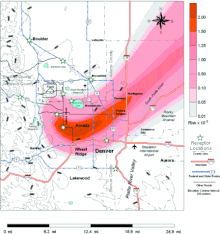
The Rocky Flats Plant, a former U.S. nuclear weapons production facility located about 15 miles (24 km) northwest of Denver, caused radioactive (primarily plutonium, americium, and uranium) contamination within and outside its boundaries.[1] The contamination primarily resulted from two major plutonium fires in 1957 and 1969 (plutonium is pyrophoric, and shavings can spontaneously combust) and from wind-blown plutonium that leaked from barrels of radioactive waste. Much lower concentrations of radioactive isotopes were released throughout the operational life of the plant from 1952 to 1992, from smaller accidents and from normal operational releases of plutonium particles too small to be filtered. Prevailing winds from the plant carried airborne contamination south and east, into populated areas northwest of Denver.
The contamination of the Denver area by plutonium from the fires and other sources was not publicly reported until the 1970s. According to a 1972 study coauthored by Edward Martell, "In the more densely populated areas of Denver, the Pu contamination level in surface soils is several times fallout", and the plutonium contamination "just east of the Rocky Flats plant ranges up to hundreds of times that from nuclear tests."[2] As noted by Carl Johnson in Ambio, "Exposures of a large population in the Denver area to plutonium and other radionuclides in the exhaust plumes from the plant date back to 1953."[3]
Weapons production at the plant was halted after a combined FBI and EPA raid in 1989 and years of protests. The plant has since been shut down, with its buildings demolished and completely removed from the site. The Rocky Flats Plant was declared a Superfund site in 1989 and began its transformation to a cleanup site in February 1992. Removal of the plant and surface contamination was largely completed in the late 1990s and early 2000s. Nearly all underground contamination was left in place, and measurable radioactive environmental contamination in and around Rocky Flats will probably persist for thousands of years. The land formerly occupied by the plant is now the Rocky Flats National Wildlife Refuge. Plans to make this refuge accessible for recreation have been repeatedly delayed due to lack of funding[4] and protested by citizen organizations.[5]
The Department of Energy continues to fund monitoring of the site, but private groups and researchers remain concerned about the extent and long-term public health consequences of the contamination.[6][7][8][9] Estimates of the public health risk caused by the contamination vary significantly, with accusations that the United States government is being too secretive and that citizen activists are being alarmist.[10]
- ^ Moore, LeRoy (2007). "Democracy and Public Health at Rocky Flats: The Examples of Edward Martell and Carl J. Johnson". In Quigley, Dianne; Lowman, Amy; Wing, Steve (eds.). Ethics of Research on Health Impacts of Nuclear Weapons Activities in the United States (PDF). Collaborative Initiative for Research Ethics and Environmental Health (CIREEH) at Syracuse University. pp. 55–97. Archived from the original (PDF) on March 31, 2012. Retrieved September 17, 2011.
- ^ Poet, SE; Martell, EA (October 1972). "Plutonium-239 and americium-241 contamination in the Denver area". Health Physics. 23 (4): 537–48. doi:10.1097/00004032-197210000-00012. PMID 4634934. S2CID 26296070. Retrieved 12 June 2013.
- ^ Johnson, CJ (October 1981). "Cancer Incidence in an area contaminated with radionuclides near a nuclear installation". Ambio. 10 (4): 176–182. JSTOR 4312671. PMID 7348208.
- ^ "Rocky Flats National Wildlife Refuge". U.S. Fish & Wildlife Service. Retrieved 2 July 2013.
- ^ Snider, Laura (2012-02-18). "Study: Rocky Flats area still as contaminated with plutonium as 40 years ago". DailyCamera. Retrieved 2 July 2013.
- ^ "The September 1957 Rocky Flats fire: A guide to records series of the Department of Energy". United States Department of Energy. Archived from the original on March 27, 2012. Retrieved September 3, 2011.
- ^ "Rocky Flats Nuclear Site Too Hot for Public Access, Citizens Warn". Environment News Service. August 5, 2010. Retrieved September 17, 2011.
- ^ Hooper, Troy (August 4, 2011). "Invasive weeds raise nuclear concerns at Rocky Flats". The Colorado Independent. Retrieved September 17, 2011.
- ^ "1969 Fire Page 7". Colorado.edu. Retrieved 2011-10-27.
- ^ "Atomic Obsession: Nuclear Alarmism from Hiroshima to Al-Qaeda". RockyFlatsFacts.com. Retrieved 4 July 2013.
© MMXXIII Rich X Search. We shall prevail. All rights reserved. Rich X Search
